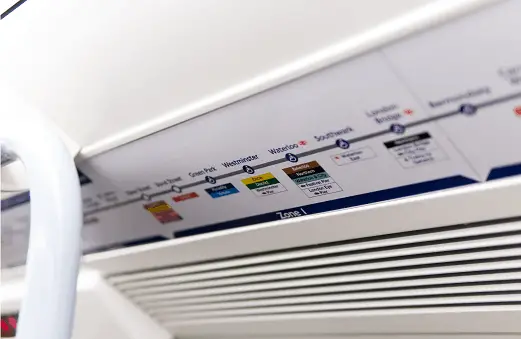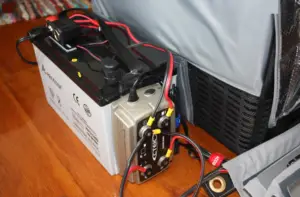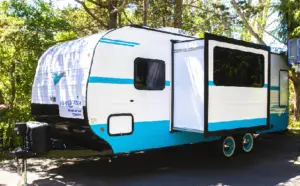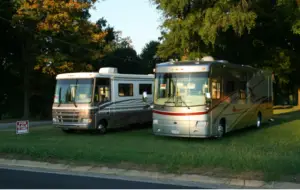An RV provides the most convenient camping experience. This experience often becomes sour when the summer heat becomes unbearable, both inside and outside the camper van. You may need to install an AC to make the interior more habitable.
This guide explains the things you need to know before installing an air conditioning unit in your camper.
You’ll also learn the types you can choose from depending on your RV, and a few other factors.
First, let’s see how you should make the decision.
Factors to consider before adding an AC to your RV
If your RV wasn’t equipped with an air conditioner then it was for a reason. It could have been a cost saving by the manufacturer or the RV was not quite designed to have that extra weight in the limited space n the RV.
Whatever may the reason be, remember it was how the manufacturer designed and made the RV.
So, adding an extra appliance like AC on the RV should not be taken lightly. This is important as the AC weighs significantly and also involves supplying power supply.
Consider below factors before you jump and make that AC addition to your RV’s roof.
1. Weight
Whenever RVing is involved, you must always be conscious of the weight you bring along. You do not want to install an AC that weighs more than your entire gear combined.
You may also have a small weight margin left from your camper’s GVWR. In this case, you have to choose an AC that won’t strain your expensive RV roof if not putting you at crosshairs with the authorities.
AC units come in various types, each type having its specific weight. Check the AC unit’s weight and countercheck with your RV before purchasing.
2. Installation space
The AC will take up considerable space off your RV. This is the main determining factor on what size of AC you should go for. The other requirement is the energy and fuel the AC unit will need to condition the RV’s internal climate.
As you decide on the size based on your vehicle size, remember that bigger units provide more reliable air conditioning. In comparison, smaller units are economical on fuel, energy, space, and cost.
3. The size and height of the RV
As is the case with air conditioning in our homes, the amount of space to be conditioned varies directly with the number of air conditioning units.
The bigger the RV, the more space to be air conditioned. You will not only need a powerful and bigger unit to sufficiently serve the RV, but you may also need a second AC. A second AC comes at a cost, more than the obvious cost of installation. We shall see more on this later on.
The height of the vehicle can determine where you install an AC. If the vehicle is short, you have more space on the roof. You may opt for an external unit on top of the roof in such cases.
4. Electrical power requirements
You probably know that air conditioners are power-hungry fixtures. They tend to consume more electrical energy than any other equipment you may have on board.
A lead-acid battery pack is not sufficient to power an AC unless you plan to idle your car throughout. A portable generator with an output of at least 3500W is suitable to work with the least power-hungry ACs. You also get extra power for your other cooling needs. We will see the watts requirements in detail below. You can check my earlier guide on watts consumption by RV AC and generator size.
Portable generators come at a cost. This cost, along with fuel costs, should be factored in before making a final decision.
5. Energy load
As mentioned above, ACs are really power-hungry. If you only have a small ‘surplus’ electrical energy, you can be assured that the AC will starve the other electrical appliances.
The present power load should indicate the size of the generator or solar PV modules you need for the setup to work.
Although buying a generator may be inevitable with an AC, look at your other electrical needs and sum everything up to determine the output you need from the generator.
This way, you won’t have to power down some of your fixtures to run the AC.
6. Insulation of the RV
It’s rather obvious that you can only condition a well-sealed space. With some RVs designed for optimum natural ventilation, you need to ensure that the only direct contact of the air inside and outside the RV is through the AC.
A poorly insulated RV will also allow more heat during summer or conduct the heat away during winter. Your AC will have to work extra hard to compensate for these energy losses. This only means more gas and more costs.
How big AC to get
When you will be spending close to $1000 on installing an AC, you better get it right. One thing that can go wrong is the Air conditioner size. AC’s are rated and measured in BTU (British Thermal Unit).
Most RV’s having length between 20 to 30 feet come with either 13,500 BTU or standard 15,000 BTU. A 15,000 BTU is a good enough size that can cool a 30 feet RV. But, it may not always be enough depending on few factors like below.
Rooms : Even if the RV is lesser than 30 feet but if it is separated with partitions or rooms then a single AC may not always be enough as the airflow may not be great.
Length : A longer RV will need higher BTU or 2 air conditioners. Its obvious, higher the area to be cooled, higher will be the size of the AC needed.
People/Things : More number people or if the RV is packed with more number of appliances or furniture the cooling wont be very good with low BTU and you may want to go ahead with higher BTU or 2nd AC.
Paint : RV paint does have an affect on how hot it can get in there. A dark color will absorb more heat and thus more energy will be spent on the AC. That’s the reason most AC’s are white in color.
Location : If you live and spend time in a more hot and humid region then better prepare yourself with a higher BTU AC or multiple AC’s.
So, what’s the best BTU? 15,000 BTU is sufficient in most standard RV’s and RV’s that go beyond 30 feet with multiple room may need a 2nd AC depending on the climate in the region you live in.
Watts Requirements
Air conditioner, refrigerator and furnace are major appliances in most RV’s that consume most power. Also, their running time is higher and therefore you need a power source that can supply it over longer time.
When you are connected to shore power you don’t have to worry, its only when you are boondocking or dry camping without any shore power hookup.
Below is the average power requirements for AC’s with different BTU rating. You can see that there are 2 columns depicting running and starting watts. Some appliances like AC’s have higher starting watts as compared to running watts.
| BTU | Starting Watts | Running Watts |
|---|---|---|
| 5000 | 1100 – 1300 W | 300 – 400 W |
| 7000 | 1600 – 1800 W | 500 – 600 W |
| 10,000 | 1900 – 2050 W | 600 – 700 W |
| 13,500 | 2700 – 2900 W | 1000 – 1300 W |
| 15,000 | 3100 – 3500 W | 1200 – 1650 W |
So, why are the watts consumed by AC’s important to understand? It is important because this watts are highest among all the appliances and will dictate how big generator you should get.
The watts required for your generator will be based on how many watts are getting consumed at a time. So, while doing the calculation you need to consider all such high consuming and high time operating appliances.
When you have a single 13,500 BTU or 15,000 BTU AC in most cases you should be fine with a 3000 to 3500 Watts generator. But, if you have 2 ACs then you will need greater than 3500 Watts generator for sure.
Again it depends on what other appliances are running in parallel to the AC. Otherwise, a smaller generator can also start and run an AC as you can see from the table that depicts the average starting and running watts for different size BTU.
Can you run RV AC on a DC battery?
Technically it is possible to run an RV AC on battery but practically it is not a great idea as the power consumed by AC is way higher and this will only discharge the batteries quickly. So, it is ideally not a great idea to run run RV Air conditioner on Battery.
Can you run the AC on solar?
Yes it is possible but one thing that you need to keep in mind is the number of solar panels you will need. Also, it is technically the same thing to run it via a battery.
In solar panel setup the solar energy is converted into electrical energy that is stored within a DC battery which can then be converted into AC power through a inverter. So, technically you are speaking the same thing as using a DC battery.
The best way therefore is to use a generator to run the AC in absence of shore power connection.
Where to install the AC unit
ACs are mostly installed on a window or on the RV’s rooftop. However, not all RVs can accommodate a window-mounted AC.
A rooftop AC requires that the roof can safely bear the extra weight. Still, you will have disturbed the vehicle’s aerodynamics, increasing air resistance. If you plan to camp far off, expect a hit on your mileage due to the extra rooftop fixture.
There’s still an option of carrying a portable unit, only that this one has to take up space inside the vehicle.
The choice of where to install the air conditioner depends on various factors. Bear them all in mind before ending up with an incompatible unit.
Adding second AC – what to bear in mind before installing an additional AC
Sometimes a single air conditioner is hardly enough, especially if the summer turns unforgiving. You also know how bad heatwaves have hit us in the past few years.
But before you can add a second unit, here are a few things to have in mind and tips to get along:
Price
A second unit comes at its own cost. Although the second unit may not need to be a huge and expensive one, the cost is still considerable.
Also, depending on the type, you may incur installations cost when an electrician does it for you. If you have the expertise, then it’ll only cost your time and supplies.
Energy load
We’ve seen that ACs are power guzzlers. Adding a second unit means increasing the energy load. The increased energy load could be I the tune of 15 amps (the typical consumption of an RV air conditioner).
Two conditioners in the RV would need a 30-amp circuit. A 50-amp circuit will be needed to power these two ACs simultaneously because there are already other power-consuming devices.
If you do not want to change the circuitry, you may have to only use one unit at a time. This would nullify the need for a second AC in the first place. Adjusting the circuitry is thus inevitable.
AC Type
You can inherently find two types of AC units in an RV- ducted and ductless AC. The ducted ACs work just like the refrigerator; they have a metal sheet all over the vehicle. Cold air blows through them and out through the vents to cool the room.
Ductless ACs, on the other hand, blows cold air. While the mechanism is simple, this type doesn’t control the amount of humidity inside the room. You may also have to include an air-purifier to work with such an AC in dusty areas.
Ductless ACs aren’t ideal as an addition to a ducted setup because they do not adequately dissipate humidity. If you have to bring in a ductless unit, you have to regularly clean your bathroom and kitchen vent to discourage mold growth.
Location
After factoring in everything else, you have to now decide where the second unit goes. You may be tempted to think of installing a vent in the kitchen or in the bathroom, but trust me, this is never the best idea.
As we’ve mentioned above, the most humidity-prevalent places are the kitchen and in the bathroom. You’re left with the bedroom, but what about the roof?
Installing the second unit on the roof is only a good idea if the first one isn’t already on the roof. RV roofs do not come with wiring for two AC units. Still, this second unit might throw off some weight, causing an imbalance.
A second AC should be installed at the closest point to ideal wiring. You do not want to spend more on longer cables, adding electrical resistance and thus more energy losses.
Apart from location, here are some other tips to keep the RV cool.
Balancing the extra weight
Installing a second unit requires a bit of math and physics. Without keen consideration, you may end up with more weight on one side of the RV.
The effect of a wrong move could have either the front or rear axles wearing out sooner than expected. Needless to say, the cost of replacement surpasses the cost of installing that second AC.
Even after balancing the weight, you need to ensure the total weight remains within the GVWR. The tongue weight must also be considered if you’re towing a trailer.
Failure to adhere to all these weight limitations could spell doom to your trailers hitch and have you stranded out in the wild waiting for help.
Battery
For those periods when your generator is off, or there aren’t any hook-up points available, you’ll depend on the battery.
Ensure your battery pack can sufficiently power your AC units concurrently for a considerable period. Nevertheless, you have to keep an eye, lest you end up with a flat battery and no means to jumpstart.
What type of AC do you need?
There are two most common types of ACs; ducted and non-ducted ACs, among others.
Ducted AC
These AC’s utilize a system of vents built into a sheet that lines the RV’s interior. When cool air flows through the vents, it cools the entire RV uniformly.
- This system can be very convenient if coupled with a thermostat.
- It provides instant cooling and without tampering with internal humidity. Still, the overall look is neat and appealing.
Non-ducted AC
These ACs blow cold air around an area to cool that area. You’ll thus see them on a window or a roof opening.
- Due to their versatility, they are light and ideal for smaller rooms.
- If your RV is small, this is a good option.
Other AC types
Rooftop AC unit
If you do not have extra space in your RV, a rooftop-mounted AC is your best bet. However, the roof must be flat, and your RV mustn’t be too high, or you risk hitting low overhangs every time.
These units are usually lightweight, with a fair share of them weighing around 100lbs. it’s not much weight for the RV, but you certainly need someone to help you get it up there.
Portable ACs
As the name suggests, these units totally portable and require practically no installation. These units make noise when in operation, and some take up lots of space.
Check my guide on installing portable AC in RV.
Window units
These are lightweight and compact ACs, ideal in almost all cases where there is a window. They’re easy to install and are highly energy efficient.
The most significant downside is their unsuitability for larger RVs unless you want the unit as a second one.
How to install an AC in an RV
Up to this point, you’ve probably decided on the way to go. You have got an AC you want to fix or replace but do not know how to go about it; relax, today we’ll cover how to fix a rooftop and a window unit.
These are the most economical and efficient types you can easily install.
Installing a Rooftop AC
- You’ll start with an existing roof vent that can work with the AC unit. If you do not have one, you can have a professional cur a new hole for you.
- Disassemble the unit by taking apart the window hardware, covers, and shade. Take care not to scratch them.
- Place the unit on the roof with the shorter side facing frontwards to reduce air resistance, and then place the gasket on the roof opening.
- Secure the unit with bolts and nuts on the holes you drilled. Go inside the RV and install interior assembly as directed on the manufacturer’s guide.
- Have your electrical hook the unit to your RV wiring. If you have the technical know-how, you could save yourself some busk and do the wiring yourself.
- Attach the console, and your AC is ready to go.
Installing a window unit
Smaller RVs and campers like the teardrop design camper make the best use of a window unit.
Since a window unit is usually designed for a traditional house window, you will need a frame to hold the unit on an RV.
Steps:
- Construct a wooden frame to hold the unit. You must, however, seal off all the remaining openings to make air conditioning efficient.
- Remove the window to leave the space where you want to mount the unit. A sliding window would have just one part of it removed.
- Mount the frame and insert the AC unit onto it. This may leave some space inside, but the AC unit will most probably wrap around most gaping holes. Fill any remaining spaces with a proper insulator.
- Plugin the power chord to an outlet to power the unit
What is the cost of installing an AC to your RV?
A rooftop RV air conditioner installation will cost anywhere between $700 and $1400. If you hire someone for the job, you will end up shelling out an extra $200 – $600.
The cost of labor depends on the technician’s experience and location. The cost may still be higher depending on the amount of work it’ll require, the type of AC, and whether or not the AC is ducted.
What are the best AC options for RVs?
There are several reputable efficient AC brands for RVs. They all fall under the categories we discussed earlier, which means they have different efficiencies. However, each is one of the best in its individual class. They include:
- Coleman Mach 15+
- Atwood non-ducted AC unit
- Dometic Penguin low profile rooftop AC unit
- Frigidaire 115V window Mounted mini AC
- HOmeLabs window AC
Wrapping it up
Installing an AC in an RV isn’t a complicated process. It can, however, be expensive to get the job done professionally, which is why most people prefer to make the upgrade themselves. If you wish for satisfactory results afterward, hire an experienced technician to fix the AC for you.
Finally, don’t forget to carry out routine maintenance of the AC unit. It’ll keep you smiling much longer.





